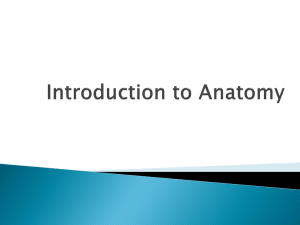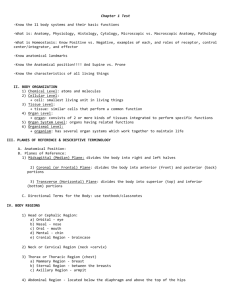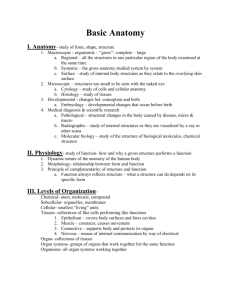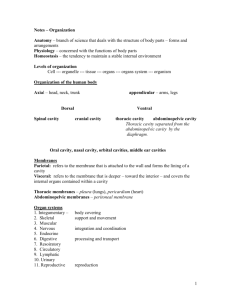CRYDERS Chapter 1 The Human Organism
advertisement
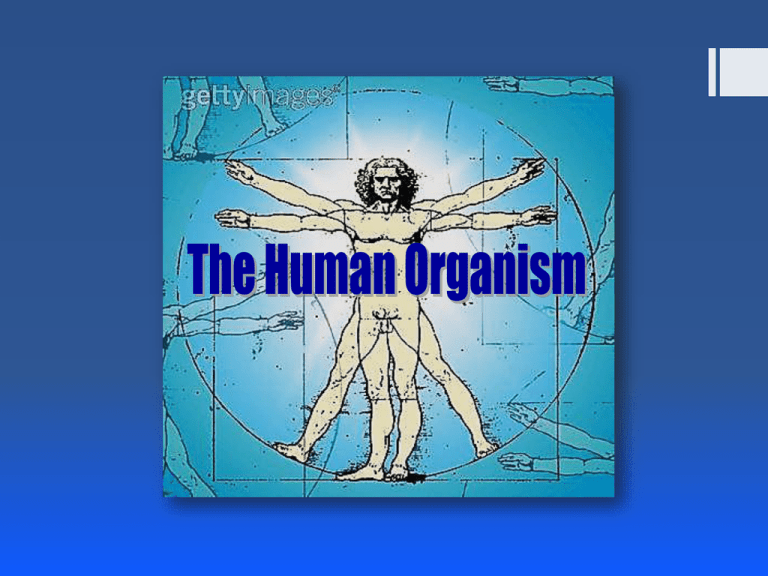
• Anatomy: Study of body structure • Physiology: Study of function of body parts Structure is always related to function • Developmental Anatomy: Study of structural changes between conception and adulthood • Embryology: Study of the changes in fetus, Changes from conception to the eighth week • Gross or macroscopic: structures examined without a microscope – naked eyes – Systemic: body is studied system by system – Regional: body is studied area by area – Surface: study of external form of body and relation to deeper structures • Microscopic: structures seen with the microscope – Cytology: study structural feature of cells – Histology: study of tissues Physiology: Study of function of body parts or living things Goal of physiology is to understand how stuff works How do muscles contract? How do we run? How does our heart beat? – Cell physiology: examines functioning of cells – Systemic physiology: studies functions of organ systems – Neurophysiology: focuses on the nervous system – Cardiovascular physiology: the heart and blood vessels • Pathology: structural and functional changes caused by disease • Exercise Physiology: changes in structure and function caused by exercise Six levels of Organization of body • Chemical Level: - atoms - atoms combine & form molecules - eg. Water, sugar, DNA • Cellular Level: Molecules combine – organelles • eg. Nucleus, Mitochondria • a cell is a collection of organelles functioning together • Cell - Smallest unit of life • Cell is the basic structural and functional unit of plants and animals Tissue Level: group of similar cells and the materials surrounding them Organ Level: one or more tissues functioning together Organ System Level: group of organs functioning together Organism Level: any living thing, eg. Human Integumentary System Eg. Skin, glands, hair, nails Forms the external body covering Protects deeper tissue from injury Synthesizes vitamin D Location of cutaneous nerve receptors regulates temperature Skeletal System Bones, ligaments, tendons Protects and supports body organs: brain, heart, reproductive organs Provides muscle attachment for movement Site of blood cell formation Stores minerals Muscular System Skeletal muscles, smooth muscles, cardiac muscles Allows locomotion and movement of contents through the organs Maintains posture Produces heat Nervous System Consists of brain, spinal cord, nerves, sensory receptors Fast-acting control system Responds to internal and external change Activates body effectors (muscles and glands) Endocrine System Endocrine glands: pineal, pituitary, thyroid, thymus, adrenal, pancreas, testis and ovaries Secretes regulatory hormones Growth Reproduction Metabolism Cardiovascular System Heart, Blood vessels Transports materials in body via blood pumped by heart Oxygen Carbon dioxide Nutrients Wastes Lymphatic System Lymphatic vessels, lymphatic glands, lymph nodes and lymph organs such as spleen, tonsils Returns fluids to blood vessels Cleanses the blood Involve in immunity Respiratory System Nasal cavity, pharynx, larynx, trachea, bronchi, lungs Keeps blood supplied with oxygen Removes carbon dioxide Production of sound Digestive System Mouth, esophagus, stomach, intestine, anus, liver, pancreas Breaks down food Allows for nutrient absorption into blood Eliminates indigestible material Urinary System Kidney, ureter, urinary bladder, urethra Eliminates nitrogenous wastes Regulates water and electrolytes Maintains acid – base balance Reproductive System Testis, penis, accessory glands, vas deferens Ovary, uterine tube, uterus vagina Production of sex cells: eggs and sperms Production of offspring Most common feature of Organism is life Characteristics of life: Organization: Specific relationships between the parts of organism and their functions Disruption of organized state – result in loss of functions Metabolism: all chemical reactions of the body • Facilitated by digestive, respiratory, cardiovascular , endocrine systems – Production of energy – Making body structures – Metabolism is necessary for growth, development, reproduction Responsiveness: ability to sense changes and adjust Growth: increase in size and/or number of cells Development: changes in an organism over time From fertilization to death Reproduction: Formation of new cells or new organisms • Homeostasis: Maintenance of a stable internal environment of the body • Internal environment is the interstitial fluid surrounding the cells • Some of the body parameters kept in a steady state: • Body temperature: regulated close to 370C • Blood pH: kept at 7.4 • Arterial blood pressure: maintain around 120/80 mm Hg • Failure of homeostasis causes diseases and sometimes death • Homeostatic Mechanisms – monitor aspects of the internal environment and corrects any changes • Eg. Sweating, shivering maintain body temperature near set point (ideal normal value) • Fluctuate around the set point to establish a normal range of values • Two types: negative and positive Feedback • Negative Feedback : maintains homeostasis • Three components: – Receptor: monitors the value of some variable – Control center: Receives information about variable from receptor & establishes the set point and controls the effector – Effector: can change the value of the variable • Not homeostatic, rare in healthy individuals • If change occurs in some variable, system responds to the change in the same direction – Eg. after hemorrhage, blood pressure drops and the heart’s ability to pump blood decreases – Which causes blood pressure to drop further – And homeostasis is not maintained – Normal positive feedback: childbirth • Anatomical Position – Person standing erect, face forward, feet together, palms face forward • Other Body Positions – Supine: lying face upward – Prone: lying face downward • Directional Terms – Describe parts of the body relative to each other – Superior (Cephalic) – up, toward the head – Inferior (Caudal) – down, toward the tail – Medial – toward midline – Lateral – away from midline – Proximal – nearest to trunk – Distal – distant to trunk – Proximal and distal terms are used when referring to limb • Superficial - near the outer surface of the organism eg. skin is superficial to the muscle layer • Deep - away from the surface of the organism eg. Muscle layer is deep to the skin • Anterior or Ventral – front • Posterior or Dorsal – back • Terminology for different parts of the body: • Upper limb is divided into: • Arm, forearm, wrist and hand •Arm: extends from shoulder – elbow •Forearm: extends from elbow – wrist • Lower limb is divided into: • Thigh, leg, ankle and foot •Thigh: extends from hip – knee •Leg: extends from knee – ankle •Central region of the body consists of: • Head, neck and trunk •Trunk can be divided into: •Thorax: chest •Abdomen: region between thorax and pelvis, inferior to ribs •Pelvis: Inferior end of the trunk associated with hip • Abdomen is sometimes divided into quadrants by two imaginary line which intersect at navel • Right-upper quadrant • Left-upper quadrant • Right-lower quadrant • Left-lower quadrant • Abdomen is sometimes divided into nine regions by four imaginary lines: • Epigastric • Right and left hypochondriac • Umbilical region • Right and left lumbar • Hypogastric • Right and left iliac • Physicians use the quadrants and regions as a reference point to locate underlying organs In order to look at the internal structure of the body, medical professionals divide the body into different sections or imaginary planes passing through it Sagittal Plane: Runs vertically through the body, separating into R and L portions Median or Midsagittal Plane: Is a sagittal plane, passes through midline of body, divide into equal R & L halves Frontal or Coronal: divides body into anterior and posterior sections Transverse / Cross: Runs parallel to ground, divides body into superior and inferior sections Planes of Section Through an Organ • To observe the internal structure, organs are sectioned: • Longitudinal: cut along the length of an organ • Cross/Transverse: cut at right angle to length of the organ • Oblique: cut at any but a right angle • Body Cavities: Spaces within the body contain internal organs • Two sets of body cavity • Dorsal body cavity – Cranial cavity - houses the brain – Spinal cavity - houses the spinal cord • Ventral body Cavity: • contains 3 cavities: • Thoracic, abdomen, pelvic • Thoracic cavity: surrounded by rib cage, contains heart, thymus, trachea, esophagus, lungs • Mediastinum : Central region divide thoracic cavity into R and L parts • Lungs are located on each side of mediastinum • Diaphragm separates thoracic cavity from abdominal cavity • Abdominal cavity: Contains stomach, intestines, liver, spleen, pancreas, kidneys • Surrounded by abdominal muscles • Pelvic cavity: Contains urinary bladder, part of large intestine, internal reproductive organs • Surrounded by pelvic bones • Abdominal and pelvic cavity is not physically separated – Abdominopelvic cavity • Serous membrane: Walls of the body cavity and outer surface of the organs are covered by thin tissue membrane known as serous membrane • Serous membranes occur in pairs separated by serous fluid – Visceral layer covers the outside of the organ – Parietal layer lines a portion of the wall of ventral body cavity • Thoracic cavity contains 3 serous membranes: • Serous membrane in the pleural (lung) cavity is called PLEURA • Visceral Pleura: Membrane surrounds the surface of lungs • Parietal Pleura: Lines the inner surface of thoracic wall • Serous membrane in the pericardial (heart) cavity is called PERICARDIUM • Serous membrane in the abdominopelvic cavity is called PERITONEUM


